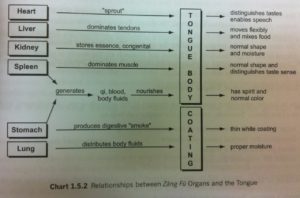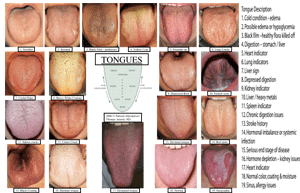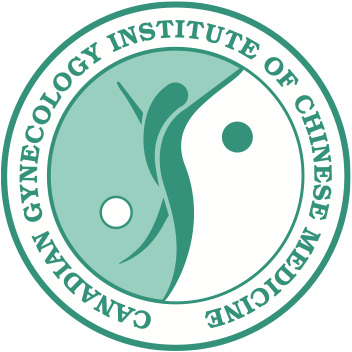The tongue plays an important role in diagnosis in Chinese Medicine.
In Chinese Medicine there are four methods of diagnosis:
- Inspection: facial complexion, body appearance, eyes, skin, hair, nails, tongue, etc.
- Listening & Smelling: sound of the voice and breath, etc.
- Inquiry: body temperature, sweating, appetite, thirst, body symptoms, bowel movements, menstrual cycle, etc.
- Palpation: pulse, area of pain, meridians of the body, etc.
Of these, the two that spark the most interest are the inspection of the tongue and palpation of the pulse. Let’s take a more in depth look at why Chinese Medicine looks at the tongue.
Surprisingly enough, the tongue changes based on the presence- or absence of pathogenic and antipathogenic Qi. Based on where the changes take place, the tongue can indicate where in the body a disease is. Although I cannot site a reference, I’ve heard that Western Medicine doctors also performed tongue diagnosis up until the early 1900’s.
Based on the tongue, a Chinese Medicine practitioner can see the state of antipathogenic Qi, distinguish thermal nature of a disease, be able to locate the disease in the body and give accurate prognosis of the disease.
Why Look at the Tongue?
Based on Qiao Yi’s text, the tongue is connected, directly or indirectly, with the channels and collaterals of all of the internal organs. Also, since there is a rich supply of Blood to the tongue and the papillae are so sensitive to change, it quickly indicates the functional activity of the body. Lastly, the acquired essence of the body, namely the Spleen and Stomach influence the appetite (and Qi and Blood) and therefore taste, which of course is related to it.
The coating is a layer on the tongue generated by Stomach Qi. A normal coating is thin and white and cannot be scraped off. It helps to look at the disease depth in the body, the thermal nature of the disease and the conditions of the Stomach. Take care though, the coating is easily influenced by many external stimuli.
How does the Tongue Relate to the Channels & Organs?
Dr. Qiao Yi has an excellent chart:

Chart 1.5.2 Relationships between Zang Fu Organs and the Tongue. Yi, Qiao (2008). Traditional Chinese Medicine Diagnosis Study Guide. Eastland Press. Seattle, WA.
What can Influence the Tongue?
There are quite a few things that can influence the tongue. When the patient sticks out the tongue, it should be relaxed. Tension can change the colour of the tongue. Otherwise, the lighting of the room, diet, medications, seasons, time of day, age, constitution, gender, complexion, hobbies and habits (smoking and drinking) can all change in the coating and should be taken into consideration.
What does a Normal Tongue Look Like?
Generally, it is medium sized, pink, has form, moves freely, and has a thin, white coating.

How Can It Change?
|
TONGUE BODY |
|||
| Attribute | Characteristic | Indication | Abnormality |
| Spirit | Vitality of the tongue | Zang, Fu, Qi, Blood, Body Fluids | Flourishing: bright with energetic movement and moist indicates good Stomach Qi |
| Withering: dark and dry tongue with sluggish movement indicates exhausted Stomach Qi | |||
| Colour | Reflects true condition of body | Thermal nature of the disease | More Red: Blood overfills tongue, more heat |
| Less Red: Qi and blood are insufficient, less heat, more deficiency | |||
| Texture | Tough or tender | Reflects excess or deficiency | Rough: exuberant antipathogenic Qi and muscle fibers bulge |
| Tender: Qi and Blood are deficient and cannot fill fibers; Yang deficiency cannot transform body fluids and cold-damp accumulates | |||
| Size | Large or Small | Often reflects constitution | Large: overfilling of Blood, damp accumulation |
| Small: lack of nutrition due to Qi, Blood and Body Fluid Deficiency | |||
| Surface | Moist, smooth | Body Fluids, heat, stasis | Cracks: malnourishment of Qi, Blood and Body Fluids due to heat or dampness obstructing |
| Prickles: heat pushes Qi and Blood up where they overfill the tongue causing papillae to thrust out | |||
| Flexibility | How the tongue moves | Condition of muscles and sinews | Stiff: lack of nourishment due to internal organ deficiency or phlegm/Blood stasis obstructing Qi and Blood resulting in stiffening of the tongue |
| Limp: sinews lack nourishment of Qi, Blood and Body Fluids and do not have the strength to move | |||
| Movement | Abnormal movement | Pathogens or deficiency | Spasm due to internal wind, usually due to hyperactive Liver, internal heat or malnutrition. Can be trembling, deviated or protruding. |
| Length | How long the tongue is | Pathogens or Internal Organs | Short: excessive cold causes contraction and spasm; malnutrition causes phlegm to stagnate and obstruct; heat injures Body Fluids; Qi and Blood deficiency due to Spleen and Kidney failure |
| Long: excess pathogenic heat consumes Qi, Blood and Body Fluids; internal organ failure resulting in the tongue being unable to contract | |||
|
TONGUE COATING |
||
| Attribute | Indications | Abnormality |
| Colour | Pathogenic factors | White: exterior or cold patterns; targets Lung and Large Intestine |
| Yellow: interior or heat patterns; targets Spleen and Stomach | ||
| Gray: interior, heat or cold-damp patterns | ||
| Black: interior, extreme heat or extreme cold patterns | ||
| Thickness | Antipathogenic Qi or depth of disease | Thin: impaired Spleen or Stomach cannot evaporate and transform dampness; Kidney and Stomach Yin deficiency cannot send up Body Fluids or damp turbidity is sent up. |
| Thick: Spleen and Stomach are stagnated by food or phlegm damp and turbid damp steam rises | ||
| Moisture | Condition of Body Fluids | Dry: excessive pathogenic heat injures Body Fluids; internal organ dysfunction leads to Yin deficiency |
| Wet: water damp attacks body due to Spleen or Kidney Yang deficiency cannot transform Body Fluids | ||
| Stickiness | Distinguishes pathogenic factors, fluid metabolism | Damp, phlegm, water or food stagnates and accumulates and the Stomach Qi produces excess turbidity that steams upwards |
| Distribution | Location and depth of disease | Even: widespread pathogen, dampness obstructs middle jiao |
| Uneven: certain body parts or organs are affected, there will be uneven distribution | ||
| Peeling | State ofStomachQi & Yin | Deficient Stomach Qi or Yin results in exuberant rising of turbid dampness or Stomach Yang, burning fluids. |
| Rooting | Pathogen severity, condition of Stomach Qi & antipathogens | Rooted: sufficient Stomach Qi that is attached to tongue tightly, difficult to scrape off |
| Unrooted: insufficient Stomach Qi due to Qi deficiency in the Stomach or Kidney | ||
The tongue is a very vascular muscle with very sensitive papillae that easily change with changing internal conditions. Examining it is a great way to see the functioning of the internal workings of the body. As with the blog on the pulse, this is a very basic overview of its structure and pathologies. Talk to your Chinese Medicine practitioner for more details or feel free to contact us.
For Practitioners: the majority of this text is based on the book: Traditional Chinese Medicine Diagnosis Study Guide, by Qiao Yi. If you haven’t had a chance to get this book, I highly recommend it. I opened it up and not only does it have thorough explanations, it has excellent diagrams and charts. As soon as I saw the diagrams and charts, I was in love.
Caroline Prodoehl, BA,CDA, D.ac, TCMP
Yi, Qiao (2008). Traditional Chinese Medicine Diagnosis Study Guide. Eastland Press, Seattle, WA.

